
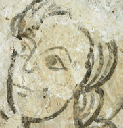


We are not exactly sure when the Lakenheath paintings were rediscovered. The wall paintings in St Mary’s Church were first reported as having been newly rediscovered by C. E. Keyser, who claimed to have visited them himself in October 1886. According to his report there were actually far more paintings uncovered than we see today, including figures of men and horses in the north aisle. We assume that many of these were in so poor a state of preservation that they were lime-washed over once again.
In total the remains of at least five individual schemes were uncovered - although this wasn’t realised at the time. However, due to the crude methods employed to uncover the paintings the individual layers have become difficult to interpret and decipher. In some areas, particularly on the plaster of the north arcade, the gouges and marks made during the original uncovering are still clearly visible. Indeed, in some places it is difficult, without the aid of scientific analysis, to establish exactly what images belong to which scheme. Luckily, the individuals involved in the nineteenth century restoration were content to simply uncover what they could and the painting were not subject to many of the restoration treatments suffered by other wall paintings discovered elsewhere. The result is that, though they look fragmentary, the paintings are now in a far better condition than they otherwise might have been.
Nevertheless, the very fact that the wall paintings have now been exposed to the elements for over a century since their rediscovery has led to them suffering considerable deterioration and significant losses have taken place. Much of this damage occurred in the early twentieth century, when the church was in a far poorer state of repairs, and, according to the experts, the actual rate of deterioration has slowed down in recent years.
In 2003 the church authorities, being aware of the significance of the wall paintings in their care, commissioned a survey to evaluate the level of deterioration being suffered by the images. The extensive and far reaching survey was carried out by Cambridge based Tobit Curteis Associates who published their findings in May of that year. The consultants had discovered that the wall paintings were in danger of suffering further severe losses unless work was undertaken to conserve them in the very near future.

In particular, it was noted that the medieval lime plaster onto which many of the images were painted, was ‘delaminating’ and coming away from the wall. If work wasn’t undertaken to stabilise the plaster then it was possible that relatively large sections of both plaster and paintings could be lost.
As a result of the report the PCC, in association with expert advisors, drew up a programme of conservation and stabilisation. The PCC and the then Rector of St Mary’s, the Rev. Robert Leach, then began to approach a number of organisations and charities to secure the financial support needed to undertake such a large-scale project. After much hard work the funding package was secured and work began in February 2009.
The actual process of physical conservation was undertaken by experts from the Oxfordshire based Perry Lithgow Partnership. A team of three conservators, under the guidance of conservation director Mark Perry, were on site for five weeks during some of the coldest weather East Anglia has known in recent years.
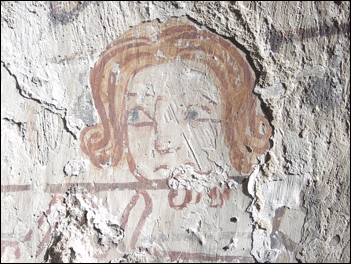
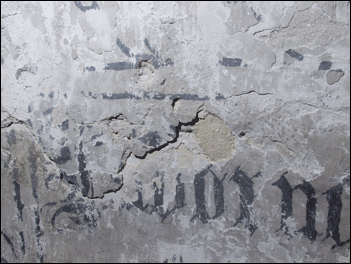
Left. Raking light image clearly showing deep gouge marks across the surface of the paintings - presumed to have been caused during the 19th century uncovering.
Right. Leaks in the roof and clerestory windows in the early 20th century had led to limewash running over the surface of the wall paintings. Here the angels of the north arcade are so obscured by the streaks of limewash as to be nearly invisible.
Left. Raking light image shows the layers of paint detaching themselves from the surface of the wall - a process known as ‘delamination’.
Right. The surface of the early 17th century text on the south arcade shows signs of damage, re-painting and surface fractures. Untreated the surface would have flaked off the walls within a very few years.
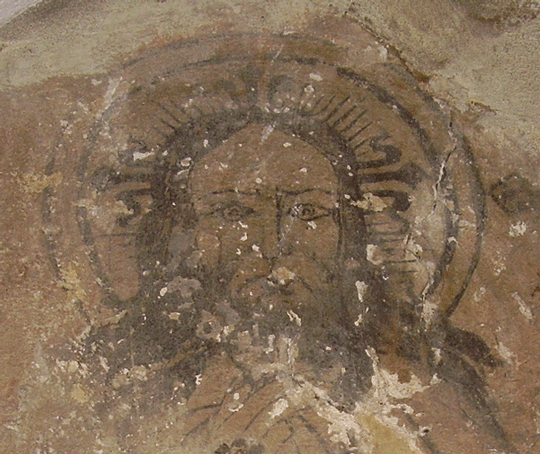
Left. Image of the face of the Risen Christ located on the south side of the chancel arch prior to conservation. This was the only image at Lakenheath that received a coating of wax during early 20th century attempts at conservation. Applying wax to medieval wall paintings was common practise until quite recent decades. Whilst it initially made the paintings look far more vibrant the wax coating caused numerous problems. The wax itself attracted dirt and dust, giving the characteristic browning of the surface.
More damaging still was the fact that the wax sealed the wall surface, allowing the build up of moisture and mineral salts in the plaster that would otherwise have evaporated out through the surface. This would eventually cause the layers of paint and plaster to ‘delaminate’ and fall away from the wall.
When examined it was discovered that this image was already largely detached from the wall. The entire central section of the painting was attached by no more than two square inches of plaster. Without conservation it would only have been a matter of months before the whole image simply fell off the wall.
Far Left. The Risen Christ after conservation. With the wax coating removed the details of this high quality image are clearly visible once more. Although largely created using only black and white pigments the sparing use of colour, such as the gold of the halo, would have created highlights that would have acted as a focus for the image.
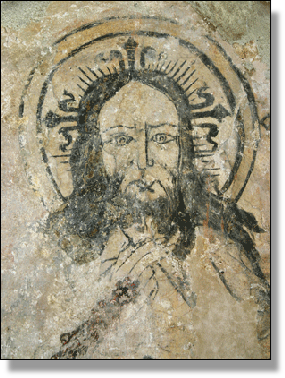
Scroll over to enlarge